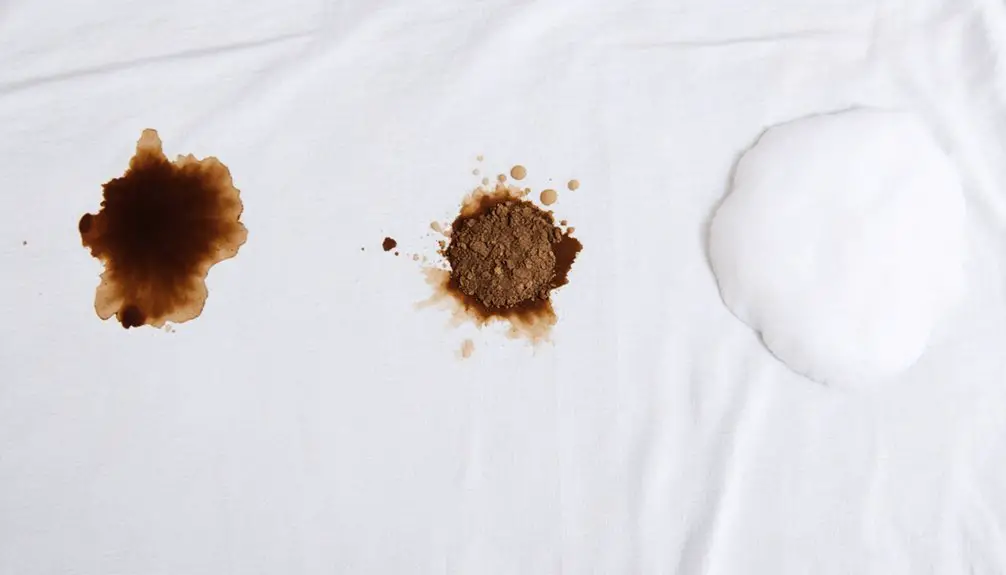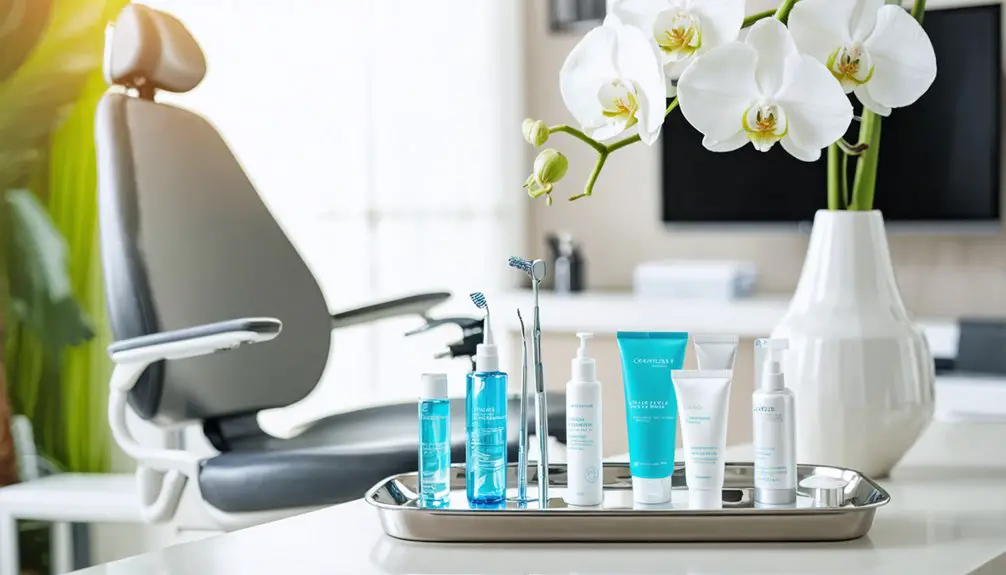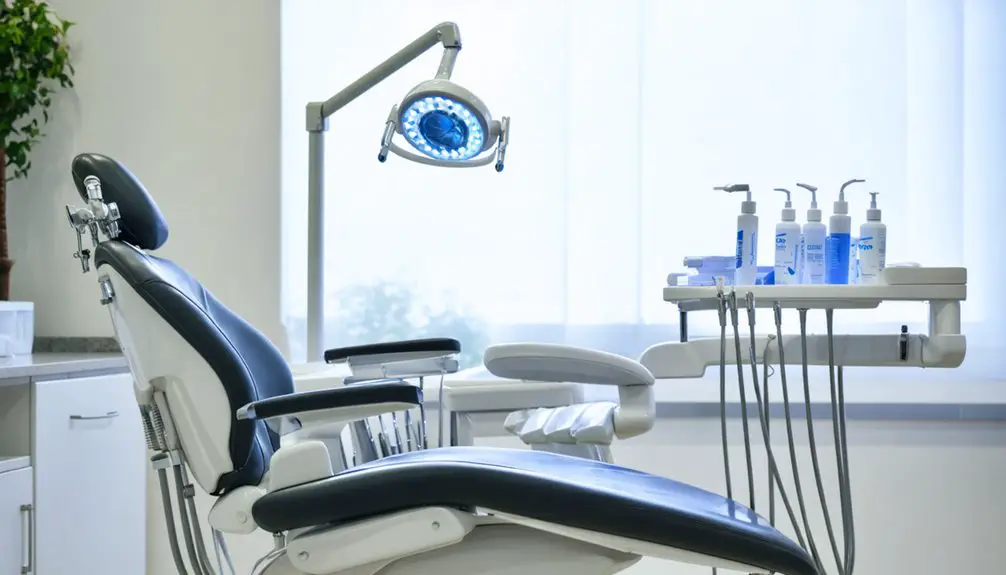Professional coffee stain removal starts with rapid blotting using clean white cloths, followed by specialized commercial cleaners like MasterBlend or Dip-It XP. You’ll need to match the cleaner to your fabric type and stain age, applying solutions with controlled pressure and proper agitation techniques. For deep-set stains, use enzyme-based cleaners combined with wet-dry vacuum extraction. Advanced techniques involving pH-balanced solutions and specialized tools offer even more powerful treatment options.
Key Takeaways
- Professional enzyme-based cleaners combined with wet-dry vacuum extraction effectively remove deep-set coffee stains from carpets and upholstery.
- pH-balanced solutions applied in sequential stages with cold water rinses prevent fabric damage while targeting coffee’s acidic compounds.
- XTREME Tea & Coffee Stain Remover’s proprietary acid blend specifically targets coffee tannins and melanoidins for thorough removal.
- Specialized agitation methods using microfiber tools with adjusted pressure ensure safe and effective stain removal on delicate fabrics.
- MasterBlend and Dip-It XP commercial cleaners provide professional-grade treatment options based on surface material and stain age.
Understanding Coffee Stain Composition
Coffee stains present a complex challenge due to their multifaceted chemical composition. When you’re dealing with these stains, you’re actually confronting multiple compounds, including tannins, chlorogenic acids, and polymeric substances that behave like nonionic pigments. These components create chemical interactions with fabric fibers that increase stain permanence over time. Hot liquid temperature significantly increases how deeply coffee penetrates fabric materials.
Understanding the particle size differences between coffee types is essential – instant coffee particles (~538 nm) are larger than filtered coffee (~134 nm), affecting how deeply they penetrate fabrics.
The slightly acidic nature of coffee (pH ~5) combined with negatively charged particles influences how the stain bonds to different materials. Natural fibers like cotton and wool are particularly susceptible to coffee stains because tannins readily form complexes with their protein structures. The brown coloration in coffee stains comes from caramel and melanoidins produced during the roasting process.
Immediate Response Techniques
You’ll need to act within seconds of a coffee spill by immediately blotting with clean, dry absorbent materials to prevent deep fiber penetration and permanent staining.
Cleaning experts recommend using cold water rinse first to prevent setting the stain deeper into fabrics.
Keep an emergency stain kit with white vinegar, baking soda, and clean cloths readily available in your home or office to address coffee accidents instantly.
For best results, always blot gently without rubbing, use cold water initially, and avoid applying heat until you’ve completely removed the stain.
Since linen’s natural fibers are highly absorbent, a prompt stain treatment will significantly increase your chances of complete stain removal.
Quick Action Saves Fabrics
When a coffee spill occurs, your immediate response can mean the difference between complete stain removal and permanent fabric damage.
You’ll need to act fast to prevent stain setting by immediately rinsing the affected area with cold water. Don’t use hot water, as it can permanently fix the stain into the fibers.
To protect fabric integrity, especially with delicate materials like linen and cotton, quickly apply household absorbents such as salt or baking soda to draw out moisture and oils.
Keep a travel stain kit handy with essential items like baking soda, white vinegar, and dish soap for addressing spills away from home.
Coffee contains natural tannins that strongly adhere to fabric fibers, making prompt treatment essential for successful removal.
Gently blot the area rather than rubbing, and follow up with a mixture of mild detergent and white vinegar in cold water.
Remember to test any treatment on an inconspicuous area first, particularly with sensitive textiles.
Avoid heat exposure until you’ve completely removed the stain.
Blotting Before Cleaning Steps
Three vital steps define successful blotting technique when addressing fresh coffee stains.
First, grab clean white cloths or paper towels – never use colored materials that might transfer dye.
Second, work from the stain’s outer edges inward using gentle pressure to concentrate the liquid toward the center.
Third, continue blotting until you’ve removed all possible moisture before applying cleaning solutions.
You’ll achieve ideal results by implementing proper blotting techniques with effective materials.
Use cold, damp paper towels for fresh spills, and maintain consistent, light pressure to protect fabric integrity.
Timely action is crucial since immediate treatment significantly increases the chances of complete stain removal.
For synthetic fabrics, follow with gentle soaking; for natural fibers, combine with cold water rinsing.
Testing your cleaning solutions on inconspicuous areas before applying them to the stain will help prevent potential damage to your fabrics.
When dealing with delicate materials like silk or wool, your immediate blotting response becomes even more essential to prevent deep stain penetration.
Emergency Supplies Ready Now
Since coffee spills demand swift action, maintaining a well-stocked emergency supply kit can mean the difference between successful stain removal and permanent damage. The most challenging stains develop when tannins bond deeply with fabric fibers.
You’ll want to assemble portable stain prevention tools that enable immediate treatment wherever accidents occur. Keep your emergency kits strategically placed in areas where coffee is frequently consumed or transported. Always remember to treat stains with cold water first before applying any cleaning solutions.
- Pack travel-size bottles filled with pre-mixed vinegar solution, along with small containers of baking soda and salt for rapid spot treatment.
- Store clean microfiber cloths and paper towels nearby for instant blotting without causing fiber damage or spreading.
- Include multiple small bottles of diluted dish soap solution that you can quickly apply to break down coffee oils before stains set.
Remember to replenish supplies regularly and keep your emergency kit easily accessible for swift response.
Commercial Cleaning Solutions
For professional coffee stain removal, you’ll need to select from specialized commercial cleaners like MasterBlend for carpets, Dip-It XP for equipment, or enzyme-based solutions for set-in stains.
When choosing between products, consider the specific surface material and stain age, as synthetic fabric cleaners require different chemical compositions than those formulated for natural fibers.
You can maximize effectiveness by combining compatible cleaning agents, such as using a presoak solution with mild acid followed by a surfactant-based cleaner, while always following manufacturer guidelines to prevent fiber damage.
Popular Stain Removal Products
When tackling stubborn coffee stains, professional-grade commercial cleaning solutions offer targeted formulations designed specifically for tannin-based discoloration. Among the best stain removers, XTREME Tea & Coffee Stain Remover stands out with its proprietary acid blend, while Redline Prespray delivers professional results for deep-set stains.
Product comparisons show that each solution serves distinct needs, from portable options like GuruNanda’s OxiClean pen to thorough treatments like Parker & Bailey’s Liquid Stain Remover.
- XTREME Tea & Coffee’s bleach-free formula proves ideal for environmentally conscious cleaning services
- Redline Prespray’s enzymatic action effectively handles cream-based coffee stains
- Instant Carpet Spot Remover’s fast-acting formula suits high-traffic commercial environments
Choose your weapon based on stain age, fabric type, and required response time for best results.
Specialized Treatment Applications
Professional-grade coffee stain removal demands specialized treatment applications tailored to specific surfaces and materials.
For carpets and upholstery, you’ll find MasterBlend Coffee Stain Remover particularly effective, treating up to 400 square feet per gallon.
When dealing with equipment and hard surfaces, Ecolab’s Dip-It XP provides superior results without damaging sensitive materials.
For delicate fabrics, you’ll want to employ enzymatic cleaners that break down organic components while preserving fiber integrity.
Start with blotting techniques using absorbent cloths, then apply your chosen solution methodically.
Remember to avoid bar soaps, which can permanently set stains. Instead, use a combination of neutral detergents followed by vinegar-based rinses.
For best results, finish by placing weighted dry absorbent materials over the treated area during drying.
Safe Chemical Combinations
Safe chemical combinations in commercial coffee stain removers rely on specific formulations that maximize effectiveness while minimizing material damage.
You’ll find that understanding chemical reactions between cleaning agents and stain properties helps you select the most appropriate solution.
Enzyme-based cleaners like MasterBlend work synergistically with surfactants to break down organic compounds, while oxygen-based formulas generate reactive species that target tannin molecules.
- Combine white vinegar with liquid dish soap for a gentle yet effective treatment that’s safe on most fabrics and carpets.
- Use neutral pH detergents with oxygenated compounds to avoid fiber damage while breaking down complex coffee molecules.
- Select enzyme-based commercial cleaners for stubborn stains, as they specifically target coffee’s organic components without harsh chemicals.
DIY Treatment Methods
Although professional cleaning services offer specialized solutions, several effective DIY methods can tackle coffee stains using common household items.
Skip expensive cleaning services – your kitchen pantry holds the secret weapons for conquering stubborn coffee stains effectively.
You’ll find salt application particularly useful as an immediate response to spills, as it quickly absorbs moisture and prevents the stain from setting. For best results, coat the affected area generously with salt and let it sit for one minute before gently blotting with a paper towel.
Baking soda offers another powerful DIY option. First, blot the stain with a cold, damp cloth, then liberally sprinkle baking soda over the dampened area.
Once the powder dries completely, it will have penetrated the fabric fibers, helping neutralize the coffee’s acidity while absorbing moisture. For stubborn stains, you may need to repeat this process before laundering.
Fabric-Specific Removal Strategies
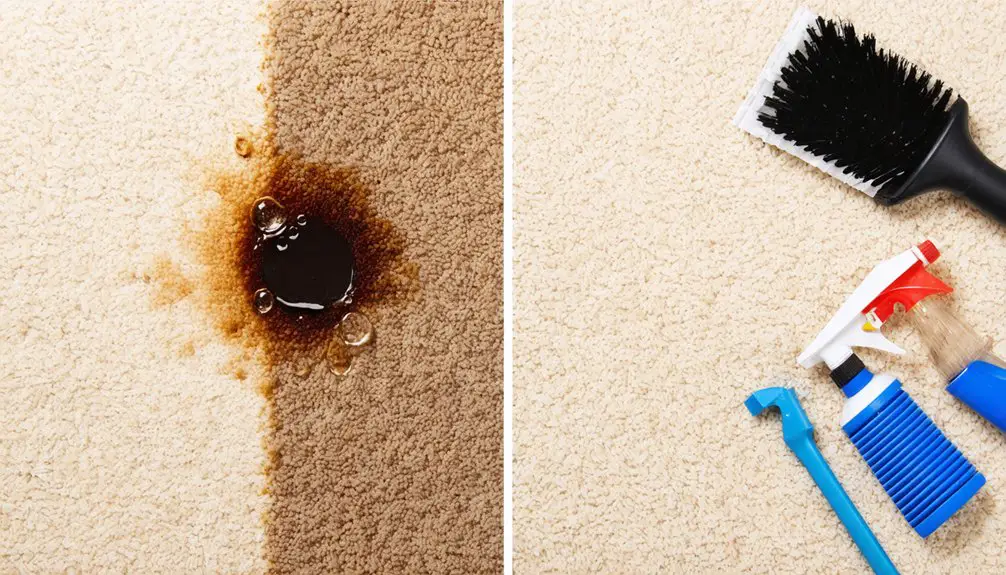
Different fabrics require unique treatment approaches when dealing with coffee stains, as their varied fiber compositions and structures demand specific cleaning methods.
When you’re helping remove coffee stains, it’s essential to identify the fabric type first and use appropriate cleaning agents. For synthetic fabrics, you’ll want to use a dishwashing detergent and vinegar solution, while wool requires gentle dabbing with cool water and mild detergent.
Cotton can withstand more aggressive treatment, but you’ll need to avoid hot water.
- For delicate fabrics, always test cleaning agents on an inconspicuous area first to prevent damage.
- Handle wool and knitwear with extra care, avoiding scrubbing to prevent pilling and fiber damage.
- Treat linen stains quickly with cold water, as its high absorbency makes stains harder to remove later.
Carpet and Upholstery Care
Removing coffee stains from carpets and upholstery requires specialized techniques beyond standard fabric treatment methods.
Standard cleaning methods fall short when tackling coffee stains – specialized techniques are essential for effective carpet and upholstery treatment.
You’ll achieve maximum stain resilience by immediately blotting fresh spills with clean, dry cloths while applying firm pressure. Don’t rub, as this can worsen the stain’s penetration.
For effective treatment, apply a mixture of water and dish soap, allowing it to dwell before gentle agitation with a soft brush.
Professional services like Hot Carbonating Extraction (HCE) can tackle stubborn stains that resist DIY methods. To promote fabric longevity, use a wet-dry vacuum to extract moisture and cleaning solutions thoroughly.
After treatment, apply protective sprays like Encapuguard to prevent future staining. Consider regular professional cleaning services, especially for high-traffic areas where coffee spills are common.
Advanced Professional Techniques
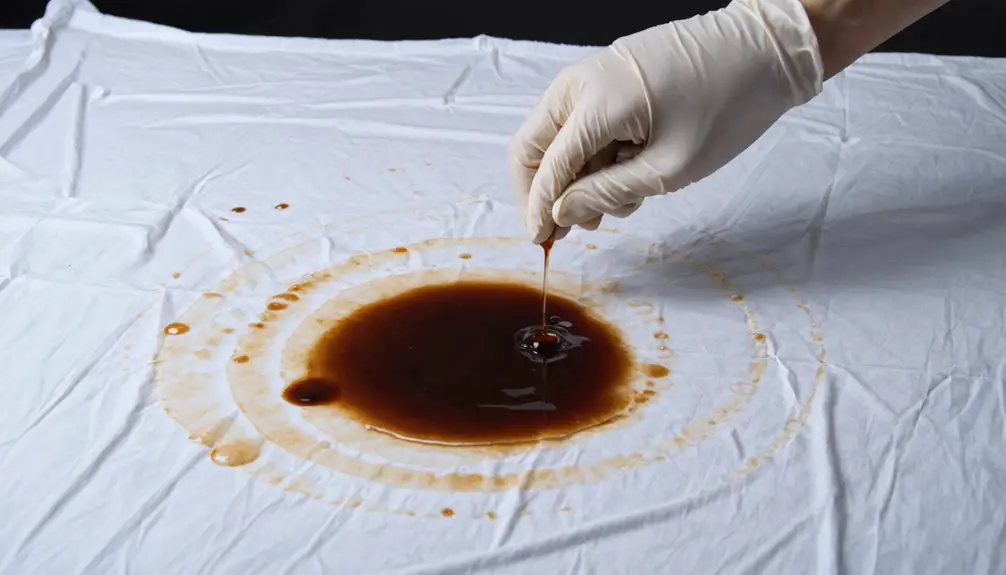
Professional stain removal specialists employ advanced chemical and mechanical techniques that surpass typical DIY methods.
When evaluating fabrics, they’ll first identify the material type and assess the stain’s age to determine the most effective treatment approach. Advanced techniques combine precise chemical solutions with controlled mechanical action, ensuring maximum stain removal without damaging delicate fibers.
- Use enzyme-based cleaners strategically with wet-dry vacuum extraction for deep-set stains in carpets and upholstery.
- Apply pH-balanced solutions in measured stages, incorporating cold water rinses between treatments to prevent fiber damage.
- Implement specialized agitation methods with microfiber tools, adjusting pressure and movement based on fabric sensitivity.
These professional-grade approaches deliver superior results while maintaining fabric integrity, particularly when dealing with delicate materials like silk or vintage textiles that require extra care.
Prevention and Protection Tips
While effective stain removal treatments are essential, implementing preventive measures can greatly reduce your need for professional intervention.
Focus on maintaining proper oral hygiene by brushing twice daily with a soft-bristled toothbrush and fluoride toothpaste, waiting 30 minutes after coffee consumption to protect acid-softened enamel. Use a straw when drinking coffee to minimize direct contact with your teeth.
Make strategic dietary adjustments by limiting sugary additives in your coffee and drinking water immediately afterward to neutralize acids.
You’ll benefit from chewing sugar-free gum post-coffee to stimulate saliva production. Consider switching to lighter roasts and avoid continuous sipping throughout the day.
Remember to schedule regular professional cleanings and use whitening products moderately to prevent enamel damage while maintaining ideal protection against stubborn coffee stains.
Troubleshooting Stubborn Stains
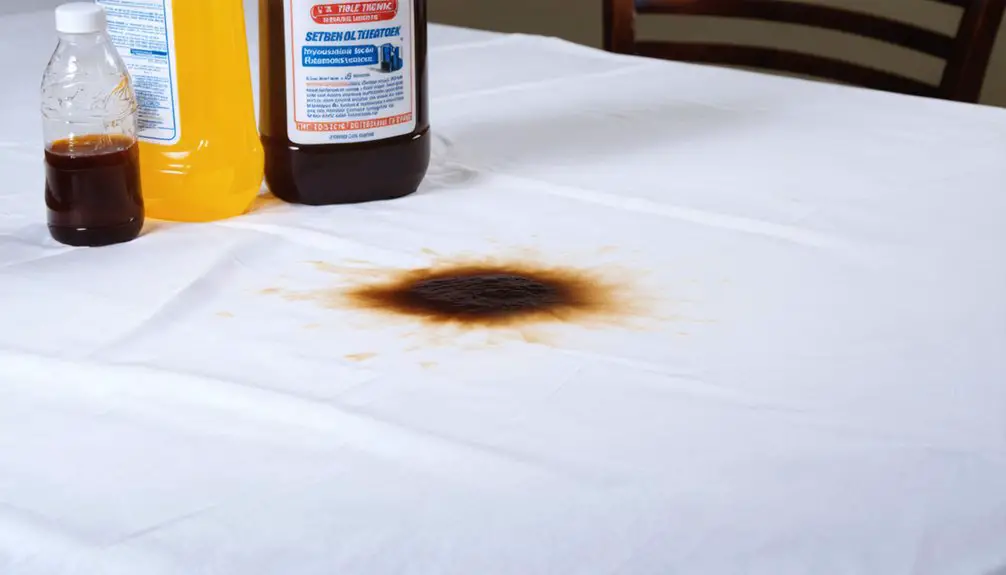
Even with preventive measures in place, stubborn coffee stains can occur and demand swift, targeted intervention.
When confronting stain persistence strategies, you’ll need to assess fabric compatibility considerations before proceeding with treatment. For synthetic materials, you can use a mixture of white vinegar and dish soap, while delicate fabrics require professional care to prevent damage.
- Apply cold water immediately, working from the stain’s outer edge toward the center to prevent spreading.
- Test cleaning solutions on an inconspicuous area first, particularly with upholstery and specialty fabrics.
- Utilize multiple applications of appropriate cleaners for set-in stains, allowing proper dwell time between treatments.
For particularly resistant stains, you may need to employ enzymatic cleaners or seek professional cleaning services, especially for valuable items or delicate materials.
Frequently Asked Questions
Can Coffee Stains Be Removed After Being Dried and Set for Months?
Quick as lightning, you can tackle those long-term coffee stains through professional removal techniques, but you’ll need patience and multiple treatments combining soaking, specialized cleaners, and expert cleaning services.
Will Bleach Effectively Remove Coffee Stains From White Fabrics?
Yes, bleach effectively removes coffee stains from white fabrics, but you’ll need to monitor fabric safety. Mix ¼ cup bleach per gallon of water, soak for 5 minutes, then rinse thoroughly.
How Soon Can Furniture Be Used After Professional Coffee Stain Treatment?
Like a thirsty sponge in reverse, you’ll need to wait 1-2 hours minimum before using your furniture after treatment. For ideal drying and treatment effectiveness, waiting up to 24 hours is best.
Do Enzyme-Based Cleaners Work Better Than Traditional Chemical Stain Removers?
You’ll find enzyme-based cleaners superior for coffee stains due to their targeted molecular breakdown and fabric-safe properties. Their stain comparison shows better long-term results than chemical cleaners’ surface-level treatment.
Can Steam Cleaning Alone Remove Coffee Stains From Upholstery?
While steam cleaning’s effectiveness can help with fresh coffee stains, you’ll need additional pre-treatments for best upholstery care results, as steam alone won’t fully remove set-in or complex coffee stains.
References
- https://www.youtube.com/watch?v=7lmFJXZD7uw
- https://driftaway.coffee/how-to-remove-coffee-stains/
- https://fiberseal.com/2023/08/25/how-to-remove-coffee-stains/
- https://www.cleantalk.co.uk/threads/coffee-stain.34331/
- https://www.nespresso.com/au/en/news/how-to-remove-coffee-stains-from-carpets-and-clothes
- https://www.scribd.com/document/49108836/fulltex1t
- https://www.bonescoffee.com/a/blog/does-coffee-stain-clothes
- https://prochem.co.uk/pdf/sdsb195.pdf
- https://link.springer.com/article/10.1007/BF02541027
- https://libertybeanscoffee.com/cleaning-tips/coffee-stain-removal-guide-for-linen/
